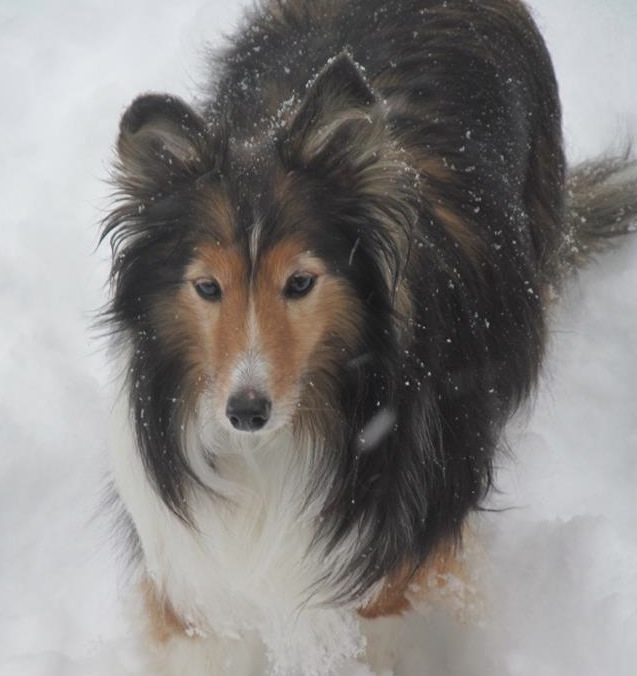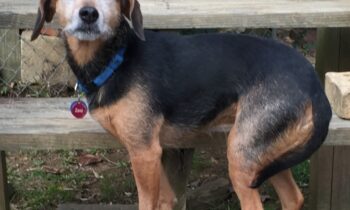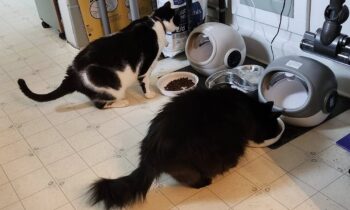
You’ve shaped your dog, using a clicker and treats, to go to a particular spot. Your dog offers that behavior consistently. He goes to the spot, he lies down on the spot. You’ve also taught your dog a down-stay (the behavior of staying in a down position until released). It’s time to combine those two skills so that, on cue, your dog goes to the spot, lies down on the spot, and stays on the spot until released.
Decide on a cue for this behavior by picking a word you feel comfortable saying—one that’s simple to remember and easy to teach others. You use a non-slip rug or mat for the spot? Your cue could be “Rug” or “Mat” (although please be sure you have no close friends or family named Matt if you choose the latter). You use a crate? I say, “Kennel,” but you might say, “Den.” It’s entirely up to you.
Wait until the dog has actually learned the behavior before you add the cue. As with words you’ve taught in the past, add the cue first as praise. For example, when you put the dog’s rug or mat on the floor, you shape the dog to go from wherever he is to the rug or mat, then to lie down on the rug or mat. When this behavior becomes consistent, start very quietly saying, “Good Mat,” as the dog lies down, at the same time you click. Then treat or jackpot!
Never use the cue as a command. You can much too easily “poison” the word by repeating it angrily, to hurry the dog up or redirect him from a distraction.
Instead, add in the cue over time in training sessions, first as quiet praise as the behavior is completed. Then consider speaking the cue a little earlier, using it to “predict” completion. When you are very sure that the dog is on his way to a successful finish (lying down), when all he has to do is to drop onto his stomach and relax, praise with the cue, “Good Mat”—quietly—as he does.

What if the dog balks at that? What if he stops dead and does not lie down after you’ve said, “Good Mat”? No click, no treat for the dog . . . but no recriminations, either. Try it again only when you can figure out why the dog reacted the way he did. In the meantime, go back to using the cue word as praise at the completion of the behavior and work your way back up. Don’t go on until the dog is ready.
When the dog is ready, move the praise-with-cue closer and closer to the beginning of the behavior—the point at which you put down the rug or mat on the floor or, if you’re using a stationary kennel or boundary (like where the rug meets the tile), the point at which you walk the dog into that area. Your goal is to enter the area with the dog, say the cue word, and have the dog immediately go to the spot and lie down on the spot. (We’ll get to the down-stay part shortly.)
Would you like the dog to go to his spot when someone rings the doorbell or knocks on the door? Would you like him on his spot when someone in the house goes to the door to go outside? The sound of a doorbell or knock and the sight of a human at the door can become cues for the behavior of going to the spot. Add those additional cues gradually, pairing the sight or sound cue with the verbal cue, then fading the verbal cue over time. You’ll then have a behavior that you can cue if you’re right there and a behavior the dog will perform on an auditory or visual cue if you’re not. By the time you get to the front hall to answer the doorbell, your dog will be in a down on his spot!
Once on the spot, your dog will stay until released if you combine his newly acquired skill of “going to mat” with his already accomplished skill of a down-stay.
▪ Lengthen the time from when the dog lies down comfortably on the mat and when you click.
▪ Add only a few seconds at a time, so the dog can be successful.
▪ Up until now, you’ve been practicing down-stays separately. Add the element of duration (how long the behavior lasts) to the down. Dog downs . . . beat, beat . . . click-treat.
▪ Add a few beats every training session as long as the dog is successful.
It will take a while to get to any appreciable duration, of course, but your job is to assure success, not to test and fail the dog.
For real-life applications, like Girl Scouts selling cookies or long-form census takers, you’ll need a lot more practice over a lot more time. That sort of situation usually comes as a surprise, so plan to “act out” similar scenarios with help from friends and family. The humans your dog gets most excited to see, whether grandparents or grandchildren, should be a part of your training, too. Remember that access to them is part of the reward to the dog for doing the behavior successfully.
Train for distracting situations year-round so you’ll be prepared. Don’t wait until Halloween or your family reunion to “test” your dog’s ability to down-stay with unusual and exciting visitors at the door.
How long is too long for a down-stay? It’s too long if your dog can’t stay down that long! In the early stages of training a down-stay, five seconds could be too long. (Remember, you want the dog to succeed, not to fail.) One second, one doggy breath, could be just right, if that’s what the dog can do. You build on that success. The down-stay of 20 minutes starts with a down-stay of just one second. Add duration, distractions, and distance and eventually you’ll have that steady 20 minutes.
So now you’ve tried clicker training. What do you think of it? Have you considered what else clicker training might help you teach your dog? Not all skills acquired through training must be practical, useful skills. Some behaviors you can teach for fun. What tricks would you like your dog to learn?



